This is a very thorough and extensive 35 page website about allopathic, holistic and integrative veterinary, cat / dog nutrition and what BigPharmaMafia, bad veterinarians and pet food companies who make very low-quality pet foods don’t or won’t tell you. It will always be a work in progress. The site is sometimes intentionally provocative & outspoken in order to disturb the status quo, which needs to be educated and must be changed! All of the information on this website is fact and has been extensively researched, sourced and documented and is extremely well received by both good veterinarians and pet parents, having had 500,000 hits in a single day!
A Look Inside a Rendering Plant
Each year in the US, 286 rendering plants quietly dispose of more than 12.5 million tons of dead animals, fat and meat wastes.

Roger Biduk: A Look Inside A Rendering Plant
Jun 24th
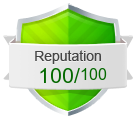 “I’ve been in a rendering plant in California and it’s not pretty”, says Roger Biduk. “I saw dead cats and dogs piled up 10 feet high, covered with maggots and worms. Employees laughed at me when I said these aren’t allow as ingredients in pet foods.”
“I’ve been in a rendering plant in California and it’s not pretty”, says Roger Biduk. “I saw dead cats and dogs piled up 10 feet high, covered with maggots and worms. Employees laughed at me when I said these aren’t allow as ingredients in pet foods.”
Employees of Sacramento Rendering have said that up to 30,000 pounds of dogs and cats a day are rendered at their plant alone. Nothing goes to waste.
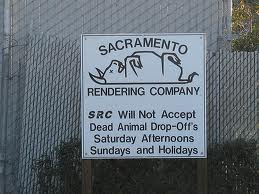 Rendering has been called “the silent industry”. Each year in the US, 286 rendering plants quietly dispose of more than 12.5 million tons of dead animals, fat and meat wastes. As the public relations watchdog newsletter PR Watch observes, renderers “are thankful that most people remain blissfully unaware of their existence”.
Rendering has been called “the silent industry”. Each year in the US, 286 rendering plants quietly dispose of more than 12.5 million tons of dead animals, fat and meat wastes. As the public relations watchdog newsletter PR Watch observes, renderers “are thankful that most people remain blissfully unaware of their existence”.
When City Paper reporter Van Smith visited Baltimore’s Valley Proteins rendering plant last summer, he found that the “hoggers” (the large vats used to grind and filter animal tissues prior to deep-fat-frying) held an eclectic mix of body parts ranging from “dead dogs, cats, raccoons, possums, deer, foxes [and] snakes” to a “baby circus elephant” and the remains of Bozeman, a Police Department quarterhorse that “died in the line of duty”.
In an average month, Baltimore’s pound hands over 1,824 dead animals to Valley Proteins. Last year, the plant transformed 150 millions pounds of 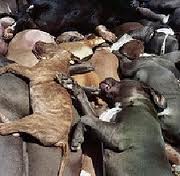 decaying flesh and kitchen grease into 80 million pounds of commercial meat and bone meal, tallow and yellow grease. Thirty years ago, most of the renderer’s wastes came from small markets and slaughterhouses. Today, thanks to the proliferation of fast-food restaurants, nearly half the raw material is kitchen grease and frying oil.
decaying flesh and kitchen grease into 80 million pounds of commercial meat and bone meal, tallow and yellow grease. Thirty years ago, most of the renderer’s wastes came from small markets and slaughterhouses. Today, thanks to the proliferation of fast-food restaurants, nearly half the raw material is kitchen grease and frying oil.
Recycling dead pets and wildlife into animal food is “a very small part of the business that we don’t like to advertise,” Valley Proteins’ President, J. J. Smith, told City Paper. The plant processes these animals as a “public service, not for profit,” Smith said, since “there is not a lot of protein and fat [on pets]…, just a lot of hair you have to deal with somehow.”
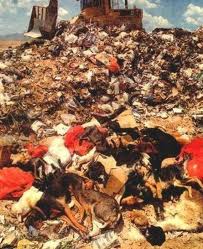 According to City Paper, Valley Proteins “sells inedible animal parts and rendered material to Alpo, Heinz and Ralston-Purina”. Valley Proteins insists that it does not sell “dead pet by-products” to pet food firms since “they are all very sensitive to the recycled pet potential”. Valley Proteins maintains two production lines, one for clean meat and bones and a second line for dead pets and wildlife. However, Van Smith reported, “the protein material is a mix from both production lines. Thus the meat and bone meal made at the plant includes materials from pets and wildlife, and about five per cent of that product goes to dry pet food manufacturers…”
According to City Paper, Valley Proteins “sells inedible animal parts and rendered material to Alpo, Heinz and Ralston-Purina”. Valley Proteins insists that it does not sell “dead pet by-products” to pet food firms since “they are all very sensitive to the recycled pet potential”. Valley Proteins maintains two production lines, one for clean meat and bones and a second line for dead pets and wildlife. However, Van Smith reported, “the protein material is a mix from both production lines. Thus the meat and bone meal made at the plant includes materials from pets and wildlife, and about five per cent of that product goes to dry pet food manufacturers…”
A 1991 USDA report states that “approximately 7.9 billion pounds of meat and bone meal, blood meal and feather meal [were] produced in 1983”. Of that amount, 34 per cent was used in pet food, 34 per cent in poultry feed, 20 per cent in pig food and 10 per cent in beef and dairy cattle feed.
The last public account of a rendering plant was provided by journalist Van Smith of the Baltimore City Paper in 1995. His article, ‘What’s Cookin’?, shocked Baltimore and the world. Smith’s Rendering Facility story provided photos of barrels full of dead dogs and cats waiting to be rendered, and a Valley Proteins employee with a hand full of meat and bone meal, one of the end products from the rendering process. The article is still available on the Baltimore City Paper website.
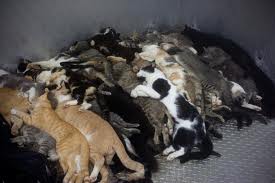 Transmissible spongiform encephalopathy (TSE) carried in pig and chicken laden foods may eventually eclipse the threat of “mad cow disease”. The risk of household pet exposure to TSE from contaminated pet food is more than three times greater than the risk for hamburger-eating humans.
Transmissible spongiform encephalopathy (TSE) carried in pig and chicken laden foods may eventually eclipse the threat of “mad cow disease”. The risk of household pet exposure to TSE from contaminated pet food is more than three times greater than the risk for hamburger-eating humans.
Pet owners have to read the ingredients in pet foods. “When you see anonymously-named ingredients such as meat and bone meal, meat meal, animal fat or animal digest on the label, these have contained the euthanasia drug pentobarbital, according to the FDA, which is used to euthanize cats and dogs”, says Roger Biduk.








